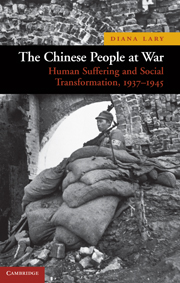Book contents
- Frontmatter
- Contents
- List of Illustrations
- List of Maps
- Preface
- Introduction: The Human Cost of War
- 1 The High Tide of War: July–December 1937
- 2 Defeat and Retreat: 1938
- 3 Stalemate and Transformation: 1939–1941
- 4 Grim Years: 1942–1944
- 5 Turning Points: 1944–1945
- 6 The Immediate Aftermath of the War: 1945–1946
- 7 The Legacy of the War
- Final Words
- Glossary
- Index
- References
Introduction: The Human Cost of War
Published online by Cambridge University Press: 05 June 2012
- Frontmatter
- Contents
- List of Illustrations
- List of Maps
- Preface
- Introduction: The Human Cost of War
- 1 The High Tide of War: July–December 1937
- 2 Defeat and Retreat: 1938
- 3 Stalemate and Transformation: 1939–1941
- 4 Grim Years: 1942–1944
- 5 Turning Points: 1944–1945
- 6 The Immediate Aftermath of the War: 1945–1946
- 7 The Legacy of the War
- Final Words
- Glossary
- Index
- References
Summary
残山剩水
A ravaged world
The Resistance War (Banian kangRi zhanzheng) (1937–45) was one of the greatest upheavals in Chinese history. It was a time of courage and sacrifice and a time of suffering and loss. Virtually the entire country was engulfed by war. All of China's major cities were occupied, as were the eastern and northeastern regions and much of the southeast. The national government was forced to move inland. Almost every family and community was affected by war. Tens of millions of people took flight. Between 20 million and 30 million soldiers and civilians died during the war.
The war was the last of a long series of foreign invasions that started in the 1840s with the Opium Wars. The leitmotif of the 2008 Beijing Olympics was that the injuries and injustice of foreign invasion were finished, that China had come into her own after her long humiliation at the hands of the outside world and regained her rightful position in the world. China's encounter with imperialism started with Western aggression, but the Japanese invasion and occupation almost a century later were by far the greatest foreign assaults that China suffered in her modern history. The ultimate external assault on China came not from the West, but from an Asian country, part of the world that China had dominated so long herself.
- Type
- Chapter
- Information
- The Chinese People at WarHuman Suffering and Social Transformation, 1937–1945, pp. 1 - 14Publisher: Cambridge University PressPrint publication year: 2010



